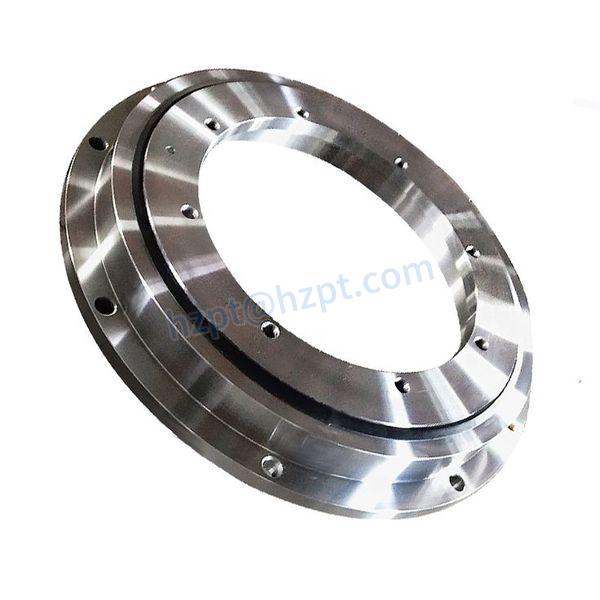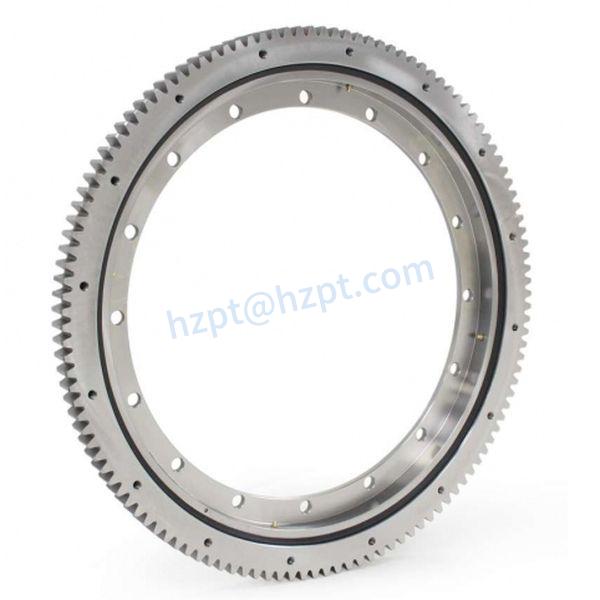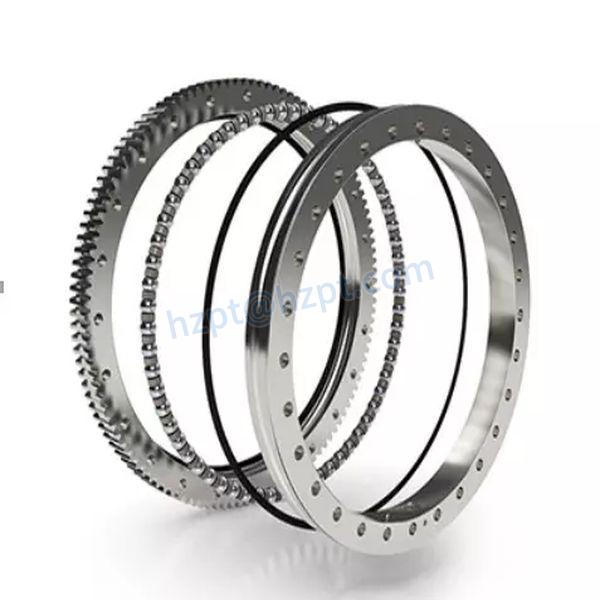Product Description
WH14 heavy load turntable slewing bearing worm gear
The slewing drive is a new type of slewing product, usually called slewing ring, which is usually composed of worm, slewing ring, housing, motor and other components. Since the core components are slewing bearings, they can simultaneously withstand axial forces, radial forces, and overturning moments. Compared with traditional rotary products, the new rotary drive features easy installation, easy maintenance and a greater degree of installation space.
Spherical worm gear reducer rotary drive device is a new type of rotary products, usually by worm, rotary support, shell, motor and other components.As the core part adopts rotary support and enveloping worm structure, it can reach multi-tooth contact, has the characteristics of large transmission torque and smooth operation, so it can bear large axial load, longitudinal load and strong overturning moment at the same time.
Compared with traditional rotating products, the spherical worm wheel rotary drive has the advantages of simple installation, easy maintenance and more space saving.The product can be widely used in the field of construction machinery and new energy, such as heavy plate transporter, container crane, truck crane, aerial working vehicle, solar power generation system and so on.
Coresun Drive Slewing Bearing Production Photo
Coresun Drive testing reports for SC products
Certification of Slewing Drive
CONTACT US
It is sincerely looking forward to cooperating with you for and providing you the best quality product & service with all of our heart!
/* January 22, 2571 19:08:37 */!function(){function s(e,r){var a,o={};try{e&&e.split(“,”).forEach(function(e,t){e&&(a=e.match(/(.*?):(.*)$/))&&1
| Holding Torque: | 48kn.M |
|---|---|
| Tilting Moment Torque: | 72kn.M |
| Output Torque: | 6.8kn.M |
| Output Speed: | 2.1rpm |
| Gear Ratio: | 84:1 |
| IP Class: | IP65 |
| Customization: |
Available
| Customized Request |
|---|

What is the Typical Lifespan of Slewing Bearings under Different Operating Conditions?
The lifespan of slewing bearings can vary based on different operating conditions and factors that influence wear and fatigue. Here’s a general overview of the typical lifespan under various scenarios:
- Light Loads and Proper Lubrication:
When operating under light axial, radial, and moment loads and with consistent and proper lubrication, slewing bearings can often exceed 20,000 to 30,000 hours of service life.
- Heavy Loads and Harsh Environments:
In heavy-duty applications where the bearings handle substantial loads, such as construction equipment or mining machinery, the lifespan might range from 10,000 to 20,000 hours. Harsh environments with dust, moisture, and corrosive substances can affect the bearing’s durability.
- Corrosive Environments:
In environments with high levels of corrosion, such as marine applications, the lifespan of slewing bearings might be reduced due to the impact of corrosive elements on the bearing’s materials.
- High-Speed Applications:
In applications requiring high rotational speeds, such as certain automation systems or machinery, the bearing’s lifespan might be affected due to increased friction and wear associated with higher speeds.
- Poor Lubrication and Maintenance:
If proper lubrication and maintenance practices are neglected, the bearing’s lifespan can be significantly shortened. Insufficient lubrication leads to increased friction and wear, potentially reducing the lifespan by a considerable margin.
- Shock and Impact Loads:
Applications subject to frequent shock and impact loads, like certain material handling equipment, can experience premature wear and fatigue, leading to a reduced lifespan.
- Temperature Extremes:
Operating in extreme temperatures, whether high or low, can affect the performance of slewing bearings and potentially reduce their lifespan due to changes in material properties and lubrication effectiveness.
- Customization and Quality:
The quality of the bearing, manufacturing processes, and the extent of customization also play a role. High-quality bearings designed for specific applications might offer longer lifespans.
- Manufacturer’s Recommendations:
Always refer to the manufacturer’s guidelines and recommendations for the specific slewing bearing model. They provide valuable insights into maintenance intervals, lubrication, and expected service life.
It’s important to note that these are general estimates, and actual lifespans can vary depending on numerous factors. Regular maintenance, proper lubrication, adherence to guidelines, and consideration of operating conditions are essential for maximizing the lifespan of slewing bearings.

How does Preload Affect the Performance and Stability of Slewing Bearings?
Preload is a critical factor that can significantly impact the performance and stability of slewing bearings. It involves applying a controlled axial force to the bearing components before assembly. Here’s how preload affects slewing bearings:
- Reduced Internal Clearance:
Applying preload reduces the internal clearance between the rolling elements and raceways. This minimizes play or clearance in the bearing, enhancing its rigidity and reducing the potential for rolling element skidding during operation.
- Improved Stiffness:
Preloaded slewing bearings exhibit higher stiffness due to the elimination of internal clearance. This improved stiffness is crucial in applications requiring precise positioning, such as robotics and high-precision machinery.
- Enhanced Load Distribution:
Preload improves the load distribution among rolling elements, minimizing stress concentrations and promoting uniform load sharing. This is especially important in applications with varying loads and forces.
- Reduced Vibrations:
By eliminating internal clearance and minimizing rolling element movements, preloaded bearings experience reduced vibrations during operation. This contributes to smoother and more stable equipment performance.
- Precise Positioning:
Preload ensures minimal movement within the bearing during rotational changes, making it suitable for applications where precise positioning and accurate motion control are essential.
- Resistance to External Loads:
Preloaded bearings are better equipped to handle external forces and shocks without significant deformation or misalignment, maintaining consistent performance even under varying conditions.
- Reduced Wear:
With reduced internal clearance and controlled movement, preloaded bearings experience less wear and fatigue. This extends their service life and reduces the frequency of maintenance.
- Limitations:
However, excessive preload can lead to increased friction, heat generation, and potential damage. It’s essential to apply the right amount of preload according to manufacturer recommendations and application requirements.
In summary, preload in slewing bearings enhances rigidity, load distribution, and stability, making them suitable for applications that demand precise movement and control. Properly applied preload ensures optimal performance and extends the operational life of the bearing.

Can you Explain the Differences Between Single-Row and Double-Row Slewing Bearings?
Single-row and double-row slewing bearings are two common configurations with distinct characteristics. Here are the key differences between them:
- Design:
A single-row slewing bearing consists of one row of rolling elements positioned between the inner and outer rings. In contrast, a double-row slewing bearing has two rows of rolling elements.
- Load-Carrying Capacity:
Double-row slewing bearings generally have a higher load-carrying capacity compared to single-row bearings. The presence of two rows of rolling elements enables them to handle heavier axial, radial, and moment loads.
- Stiffness:
Double-row bearings offer higher stiffness due to the additional row of rolling elements. This stiffness can be advantageous in applications where precise positioning and resistance to deflection are crucial.
- Compactness:
Single-row slewing bearings are typically more compact and have a smaller profile compared to double-row bearings. This compact design can be advantageous in applications with limited space.
- Cost:
Single-row slewing bearings are generally more cost-effective compared to double-row bearings. The increased complexity and higher load capacity of double-row bearings can result in higher manufacturing costs.
- Applications:
Single-row slewing bearings are suitable for applications with moderate loads and rotational requirements, where compactness is important. Examples include small cranes, excavators, and material handling equipment. Double-row slewing bearings are often used in larger and heavier machinery, such as construction equipment, wind turbines, and heavy-duty cranes.
- Performance Trade-offs:
While double-row bearings offer higher load capacity and stiffness, they may also introduce higher friction and slightly reduced rotational efficiency compared to single-row bearings due to the presence of additional rolling elements.
In summary, the choice between single-row and double-row slewing bearings depends on factors like load requirements, available space, and desired stiffness. Each configuration has its own advantages and trade-offs, allowing engineers to tailor their selection to the specific needs of the application.


editor by CX 2024-04-25
by
Tags:
Leave a Reply